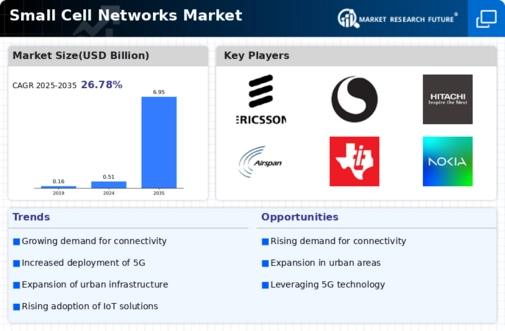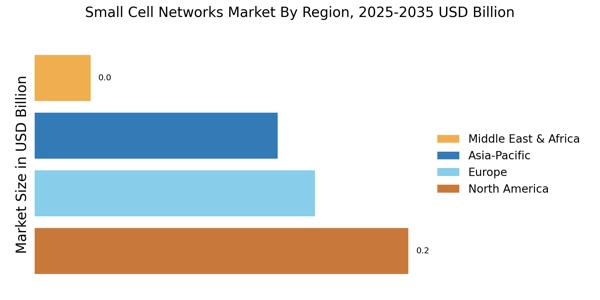Support for 5G Deployment
The transition to 5G technology is a pivotal driver for the Small Cell Networks Market. 5G networks require a denser infrastructure of small cells to deliver the promised high speeds and low latency. As telecommunications companies invest heavily in 5G rollouts, the demand for small cell solutions is expected to rise significantly. Reports indicate that the 5G small cell market could reach a valuation of over 10 billion dollars by 2026. This investment not only enhances network performance but also encourages innovation in applications such as augmented reality and smart transportation, further stimulating the Small Cell Networks Market.
Rising Mobile Data Traffic
The Small Cell Networks Market is experiencing a surge in mobile data traffic, driven by the proliferation of smartphones and IoT devices. As users demand higher data rates and seamless connectivity, traditional macro cell networks struggle to meet these needs. Small cells, which are designed to enhance coverage and capacity in densely populated areas, are becoming increasingly essential. According to recent estimates, mobile data traffic is projected to grow exponentially, potentially reaching 77 exabytes per month by 2025. This growth necessitates the deployment of small cells to alleviate congestion and improve user experience, thereby propelling the Small Cell Networks Market forward.
Government Initiatives and Funding
Government initiatives aimed at improving telecommunications infrastructure are playing a crucial role in the Small Cell Networks Market. Various countries are implementing policies to promote the deployment of small cells as part of broader efforts to enhance connectivity and support economic growth. Funding programs and incentives are being introduced to encourage local governments and private enterprises to invest in small cell technology. This support is particularly evident in urban areas, where the need for enhanced connectivity is most pressing. As a result, the Small Cell Networks Market is likely to benefit from these initiatives, fostering a conducive environment for growth.
Growing Demand for Enhanced User Experience
The Small Cell Networks Market is increasingly driven by the demand for enhanced user experience. Consumers expect seamless connectivity, high-speed internet, and minimal latency, particularly in urban environments. Small cells are uniquely positioned to address these expectations by providing localized coverage and offloading traffic from macro networks. As user experience becomes a key differentiator for service providers, the adoption of small cell technology is expected to rise. Market analyses suggest that improving user satisfaction through better connectivity could lead to increased customer loyalty and retention, thereby propelling the Small Cell Networks Market to new heights.
Increased Focus on Indoor Coverage Solutions
The Small Cell Networks Market is witnessing a heightened emphasis on indoor coverage solutions. As businesses and consumers alike seek reliable connectivity within buildings, small cells offer an effective means to enhance signal strength and quality. Enterprises are increasingly adopting small cell technology to support their operations, with a notable increase in deployments in commercial spaces, shopping malls, and airports. This trend is underscored by the fact that approximately 80% of mobile data is consumed indoors. Consequently, the demand for small cell solutions tailored for indoor environments is likely to drive growth in the Small Cell Networks Market.


















Leave a Comment